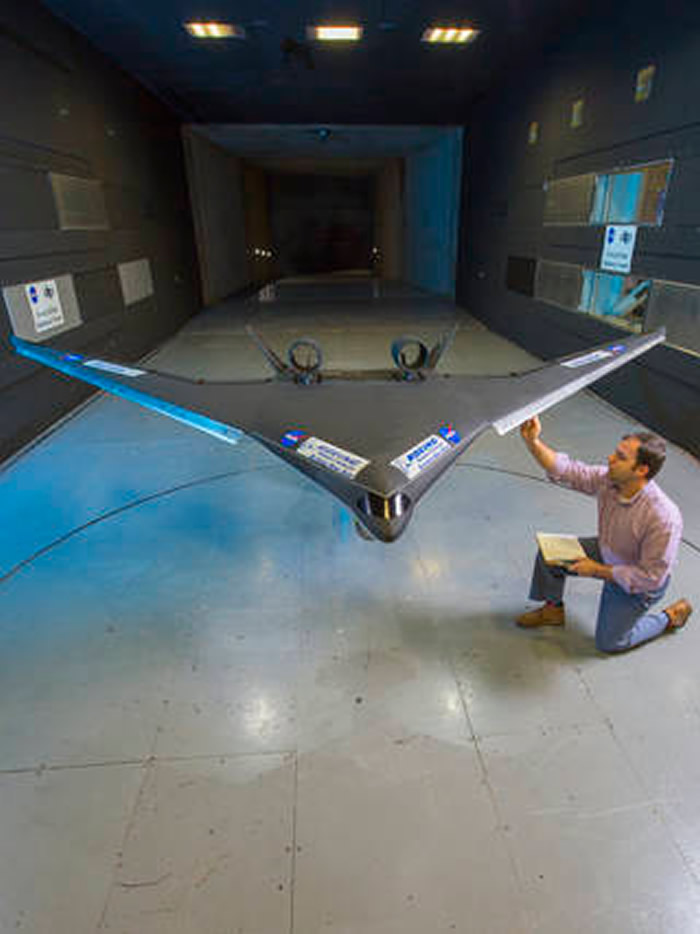Boeing Blended Wing Body spacecraft tested by NASA
NASA are already testing concepts that could be candidates, as their aeronautics engineers prepare to develop a series of greener, quieter, faster X-planes. One of those is a Blended Wing Body (BWB). A 6% scale model of a Boeing BWB is being tested for six weeks in the 14x22ft. Subsonic Tunnel at NASA’s Langley Research Center in Hampton, Virginia.
“We’re happy to have the model back in our wind tunnel,” said Dan Vicroy, Principal Investigator at NASA Langley. “It gives us a couple of opportunities – to add to our knowledge about this configuration as well as how to improve our testing methods.”
A blended wing body doesn’t look like a conventional airplane. Instead of the usual tube and wing design – it’s shaped more like a triangle where the wings are, in essence, merged into the body. Another difference is that it does not have a tail.
This same model was put through its paces in the Langley 14-by 22-Foot tunnel in 2014 and in the 40x80ft. Wind Tunnel at NASA’s Ames Research Center in California in 2015. That work was part of NASA’s Environmentally Responsible Aviation program, which developed technologies to improve fuel efficiencies, lower noise levels and reduce emissions.
But for this test it looks a little different. The top of it has been painted in non-reflective matte black to accommodate laser lights that will sweep across the model in sheets. NASA and Boeing researchers will use those laser sheets combined with smoke in the technique known as particle imagery velocimetry or PIV. That will map the airflow over the model.
“We didn’t get the opportunity to use PIV in the previous tests,” added Vicroy. “It helps us analyse the flow going into the engine inlets, which is one of the challenges with this design since the engines are on top of the fuselage, toward the rear.”
In most planes flying today the engines are out on the wings, in front, where there is nice clean airflow. Anything in front of an engine can disrupt the flow.
“Airflow makes a difference in how well the engine performs,” said Vicroy. “It’s a matter of how much distortion the engine is seeing. So if you want the engines to perform well you want to have the distortion at a minimum.”
So if engineers have to worry about airflow – why change where the engines are? Researchers say putting them on top of the plane helps shield noise, especially from people on the ground, and contributes toward NASA’s goals of developing greener, quieter planes.
The other benefit to NASA from this test has more to do with the tunnel itself. The 14x22ft. tunnel recently completed repairs and an upgrade, so having the same model return can verify how well it’s working. And having the same model tested in a totally different facility, such as the one in California also helps add to engineers’ knowledge base.
“In wind tunnel testing we have to account for how the model is installed, the size and proximity of the tunnel walls in the test section and other factors,” said Vicroy. “Testing the same model in two very different tunnels gives us data to improve our test correction methods, some of which were developed in 1940s.” For Boeing the tests are part of an ongoing research development program.
“Our tests are a continuation of more than two decades of successful research and development of this concept, which is unparalleled in industry,” said John Bonet, Boeing’s Test Director for the BWB. “What we learn from this round of testing will be used to complete the definition of our aerodynamic, stability and control low-speed databases – a major milestone in the technology development of the concept.”
With the exception of Boeing proprietary technology, NASA knowledge gained from this collaborative research will be documented and publicly available to benefit the aviation industry.
More information: NASA



Comments are closed, but trackbacks and pingbacks are open.